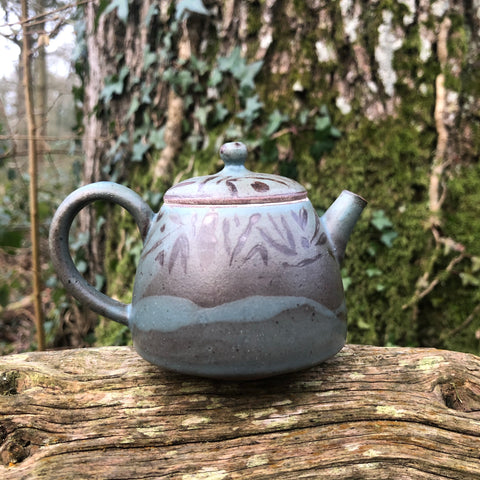‘Xing Xiang Clay Pot' Side Handle Dark Brown : Xing Xiang [Yu Xinrong] Jingdezhen
Xing Xiang Clay Pot : made from a combination of Jingdezhen clay & Yixing purple clay : Xing Xiang [Yu Xinrong] Jingdezhen
These are pots with excellent permeability made from a preparation of purple clay and jingdezhen clay
Michelle explains how we found she met Xing Xiang : On my first trip around Taoxichuan market in Jingdezhen I came across Yu Xinrong and his wife. Their beautiful cups drew me in. Born in December 1984 Yu is a graduate of Hebei Qinhuangdao Yanshan University where he studied at the sculpture art and design institute. On the year of his graduation, 2012, he started his business and is one of the new generation of young ceramicists who want to develop a new take on traditional ceramics and continue the tradition of Jingdezhen.
You can read all the details about this product on our blog
Extract from Tales of the Tea Trade
Born in 1987 in Jingzhou, Wubei Province, Xing Xiang followed the teaching and guidance of Professor Sun Ji Dong, focusing his research in the Buddha Arts of the Wei and Jin dynasties and graduating with a bachelor degree from the University of Yan Shan in 2012. After traveling he settled in Jindezhen to continue his research in ceramic materials, vessels, and the art of Buddha sculptures before establishing his studio in 2014 to create and research Buddha sculptures, tea wares and various other utensils. He spent three years researching the glaze art of ‘Zhi Ye’, successfully developing his own specific glaze, which he applies to his artworks.
Kiki: ‘We only use Jindezhen’s natural mineral clay that contains iron element to produce the vessel body. Different types of clay and glaze have an important influence in tea making. The clay affects not only the pure taste of the tea, but is also important in setting the right aesthetic moods for tea tasting in different environments.’ At home and in the workshop Kiki and Xing Xiang explore tea widely. ‘Generally, as we enter the autumn, we will choose cooked puer tea, sometimes we add a plum making it taste even better. This seems suitable for times when we lack appetite or our intestines and stomach are uncomfortable. Black tea is a year-round favourite, especially Yunnan black tea; we love the scent of sweet potato, and in the winter we may choose to add milk. We generally like to cook white tea in the summer. Jingdezhen is a humid city – it can be very wet – and for us white tea has the medicinal properties that help us overcome summer colds with a sweet bitterless taste.’


![‘Xing Xiang Clay Pot' Side Handle Dark Brown : Xing Xiang [Yu Xinrong] Jingdezhen](http://cominstea.com/cdn/shop/products/image_82f34f6a-f94d-4746-816c-b3ee75e38116_1024x1024.jpg?v=1613410591)
![‘Xing Xiang Clay Pot' Side Handle Dark Brown : Xing Xiang [Yu Xinrong] Jingdezhen](http://cominstea.com/cdn/shop/products/image_82f34f6a-f94d-4746-816c-b3ee75e38116_grande.jpg?v=1613410591)
![‘Xing Xiang Clay Pot' Side Handle Dark Brown : Xing Xiang [Yu Xinrong] Jingdezhen](http://cominstea.com/cdn/shop/products/image_2622041f-86fa-4c58-ba82-cc071f4ec189_grande.jpg?v=1613410591)
![‘Xing Xiang Clay Pot' Side Handle Dark Brown : Xing Xiang [Yu Xinrong] Jingdezhen](http://cominstea.com/cdn/shop/products/image_b5689192-102a-4a4b-9f1a-7fc22f78015a_grande.jpg?v=1613410591)
![‘Xing Xiang Clay Pot' Side Handle Dark Brown : Xing Xiang [Yu Xinrong] Jingdezhen](http://cominstea.com/cdn/shop/products/image_ffda0451-0046-4638-afbf-0191d569f039_grande.jpg?v=1613410591)
![‘Xing Xiang Clay Pot' Side Handle Dark Brown : Xing Xiang [Yu Xinrong] Jingdezhen](http://cominstea.com/cdn/shop/products/image_4f315240-72c8-4a53-999f-032297bd27d9_grande.jpg?v=1613410591)
![‘Xing Xiang Clay Pot' Side Handle Dark Brown : Xing Xiang [Yu Xinrong] Jingdezhen](http://cominstea.com/cdn/shop/products/image_5535f1bb-b9d7-45fe-a362-0e6e675c4f93_grande.jpg?v=1613410591)
![‘Xing Xiang Clay Pot' Side Handle Dark Brown : Xing Xiang [Yu Xinrong] Jingdezhen](http://cominstea.com/cdn/shop/products/image_cdf9d6f5-9d11-48bb-bc45-6a1f24e6d744_grande.jpg?v=1613410591)
![‘Xing Xiang Clay Pot' Side Handle Dark Brown : Xing Xiang [Yu Xinrong] Jingdezhen](http://cominstea.com/cdn/shop/products/image_3aba83e8-47d2-4656-8705-8f10625f337a_grande.jpg?v=1613410591)

![210ml Carved coloured pearl silver teapot [Seong Il Hong : Boseong, South Korea ]](http://cominstea.com/cdn/shop/files/61B2F7B0-B3D8-4072-930E-57CC8DC7D540_large.jpg?v=1731847946)
![‘Xing Xiang Clay Pot' : Xing Xiang [Yu Xinrong] Jingdezhen](http://cominstea.com/cdn/shop/products/image_a3475563-2ec6-4c5a-950e-72eca9a93f85_large.jpg?v=1613410372)
![Mineral Powder Painted tea cup [Cherry Pink] | Yangyang Li, YUNBAI STUDIO, Jingdezhen](http://cominstea.com/cdn/shop/products/image_ac2a0b3b-bd2f-4f35-8b0b-8c8a9e23709c_large.jpg?v=1612978598)